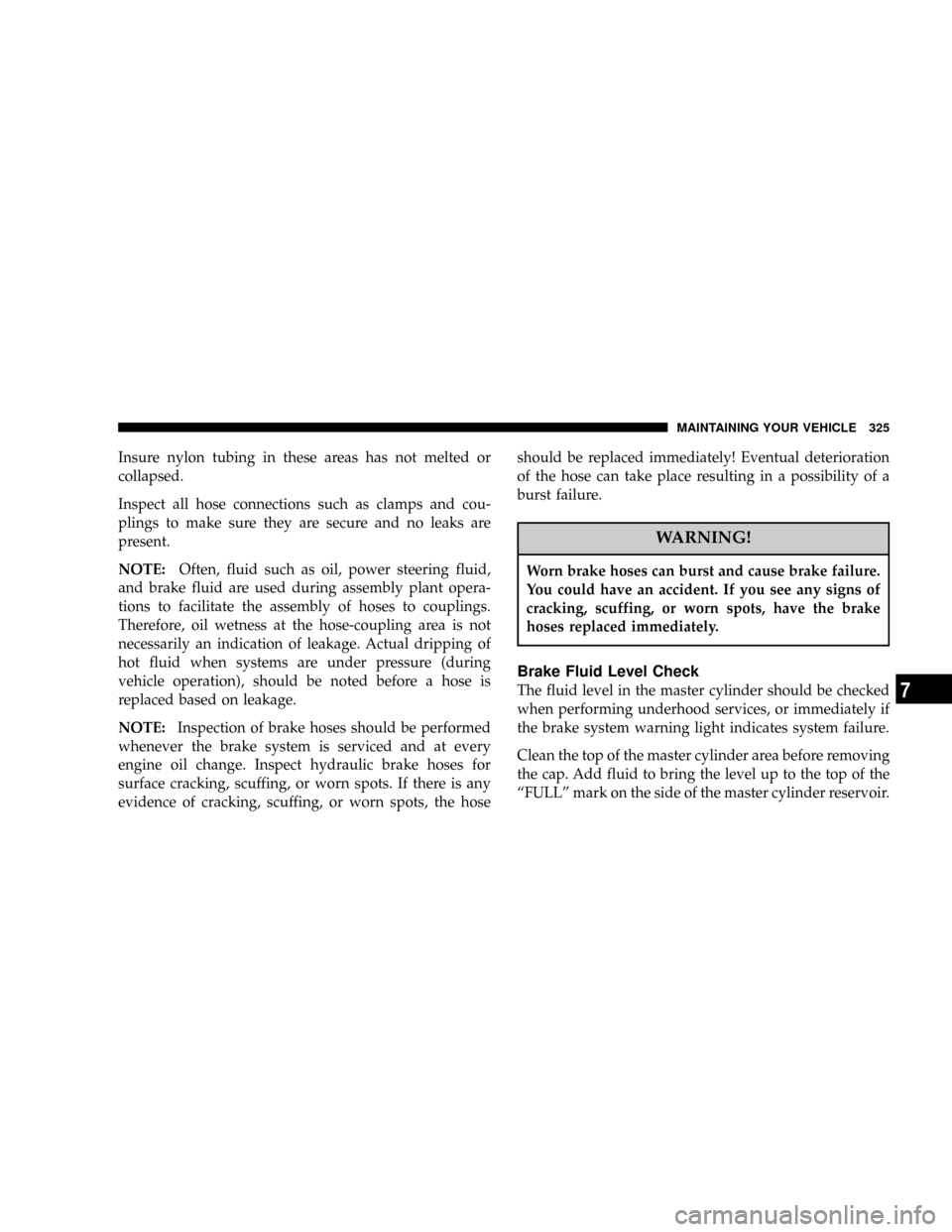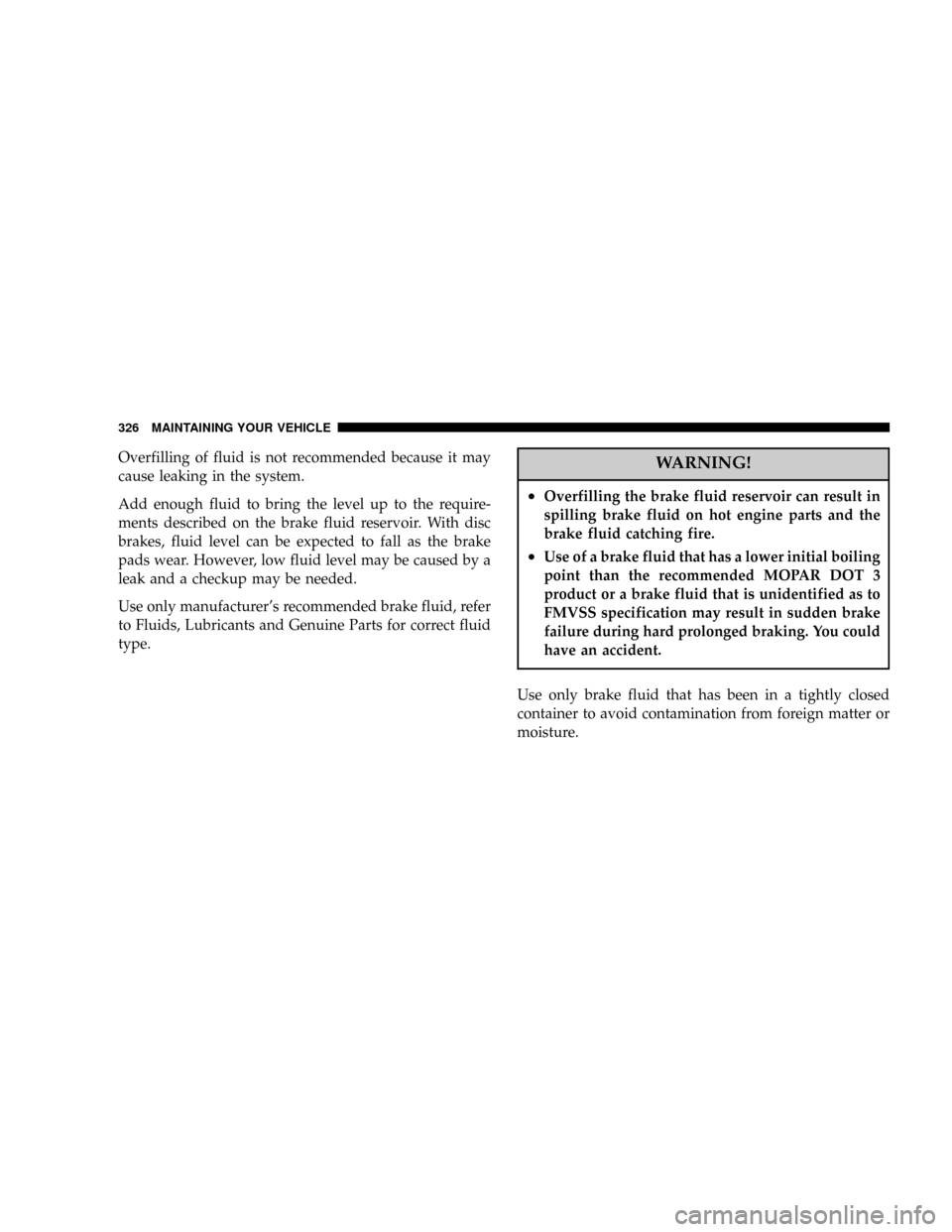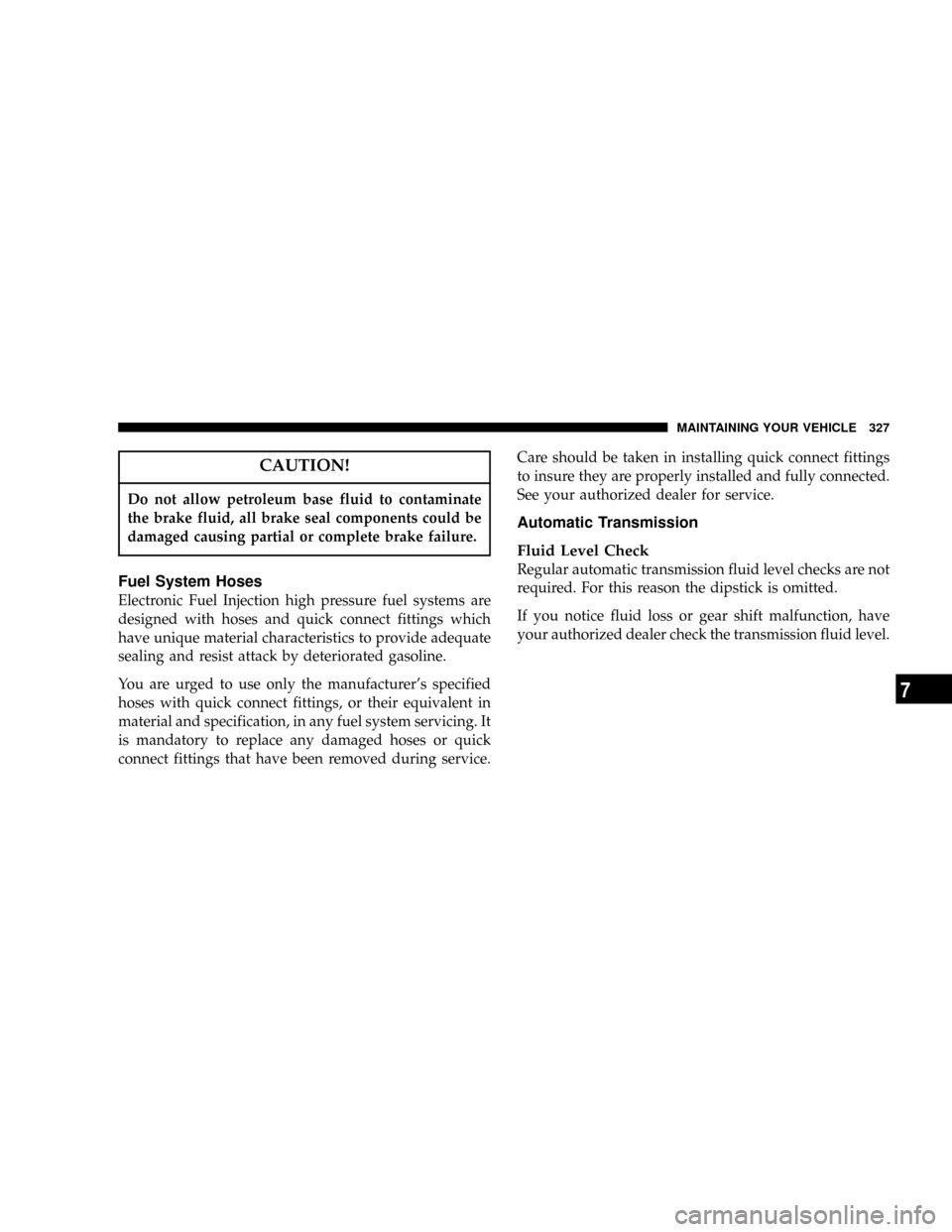Page 172 of 395

INSTRUMENT CLUSTER DESCRIPTION
1. Speedometer
Indicates vehicle speed.
2. Brake Warning Light
The BRAKE warning light will come on when
the ignition is first turned on, and stay on
briefly as a bulb check. If the bulb does not
come on during starting, have the bulb re-
paired promptly. If the light stays on longer, it may be an
indication that the parking brake has not been released.
If the light remains on when the parking brake is off, it
indicates a possible brake hydraulic system malfunction
or low fluid level. In this case, the BRAKE warning light
will remain on until the cause is corrected. If a brake
malfunction is indicated, immediate repair is necessary
and continued operation of the vehicle in this condition is
dangerous.3. Turn Signal Indicator Light
The arrow will flash with the exterior turn signal
when the turn signal lever is operated.
If the vehicle electronics sense that the vehicle has
traveled about one mile with the turn signals on, a chime
will sound to alert you to turn the signals off. If either
indicator flashes at a rapid rate, check for a defective
outside light bulb.
4. High Beam Indicator Light
Indicates that headlights are on high beam.
5. Malfunction Indicator Light
This light is part of an onboard diagnostic system
called OBD II that monitors engine and auto-
matic transmission control systems. The light will
illuminate when the key is in the ON position before
172 UNDERSTANDING YOUR INSTRUMENT PANEL
Page 180 of 395
²LIFTGATE/DOORS OPEN (with graphic)
²LIFTGLASS OPEN (with graphic)
²HOOD OPEN (with graphic)
²HOOD/DOOR OPEN (with graphic)
²HOOD/DOORS OPEN (with graphic)
²LIFTGATE/HOOD OPEN (with graphic)
²HOOD/GLASS/DOOR OPEN (with graphic)
²HOOD/GLASS/DOORS OPEN (with graphic)
²HOOD/GATE/DOOR OPEN (with graphic)
²HOOD/GATE/DOORS OPEN (with graphic)
²LIFTGLASS/DOOR OPEN (with graphic)
²LIFTGLASS/DOORS OPEN (with graphic)
²LIFTGLASS/HOOD OPEN (with graphic)
²WASHER FLUID LOW (with graphic)
²UPSHIFT (with graphic)
²CHECK GAUGES
²AUTO HIGHBEAM ON
²AUTO HIGHBEAM OFF
²PARK ASSIST DISABLED
²SERVICE PARK ASSIST SYSTEM
²TRANSMISSION OVER TEMP
²LOW BRAKE FLUID LEVEL
²WARNING! LIMIT SPEED
²CHECK GAS CAP
²ESP OFF
²MEMORY #1 POSITIONS SET
180 UNDERSTANDING YOUR INSTRUMENT PANEL
Page 294 of 395

WARNING!
Battery fluid is a corrosive acid solution; do not
allow battery fluid to contact eyes, skin or clothing.
Don't lean over battery when attaching clamps or
allow the clamps to touch each other. If acid splashes
in eyes or on skin, flush contaminated area immedi-
ately with large quantities of water.
A battery generates hydrogen gas which is flam-
mable and explosive. Keep flame or spark away
from the vent holes.
Do not use a booster battery or any other booster
source that has a greater than 12 volt system, i.e. Do
not use a 24 volt power source.
1. Remove all metal jewelry such as watch bands or
bracelets which might make an unintended electrical
contact.2. Park the booster vehicle within cable reach but with-
out letting the vehicles touch. Set the parking brake on
both vehicles, place the transmission in P (Park), and turn
the ignition OFF.
3. Turn off the heater, radio, and all unnecessary electri-
cal loads.
4. Connect one end of a jumper cable to the positive
terminal of the booster battery. Connect the other end of
the same cable to the positive terminal of the discharged
battery.
WARNING!
Do not permit vehicles to touch each other as this
could establish a ground connection and personal
injury could result.
294 WHAT TO DO IN EMERGENCIES
Page 298 of 395

NPower Steering Fluid Check..............314
NBody Lubrication.....................316
NWindshield Wiper Blades................316
NWindshield Washers Ð Front And Rear.....316
NExhaust System......................317
NCooling System.......................318
NHoses And Vacuum/Vapor Harnesses.......323
NBrake System........................324
NBrake Fluid Level Check................325
NFuel System Hoses....................327
NAutomatic Transmission................327
NFront And Rear Wheel Bearings...........329NAppearance Care And Protection From
Corrosion...........................329
mFuse Panel...........................333
NInterior Fuses........................333
NUnderhood Fuses
(Power Distribution Center)..............336
NUnderhood Fuses
(Integrated Power Module)..............338
mVehicle Storage........................339
mReplacement Bulbs......................340
mBulb Replacement......................341
NHead Light..........................341
NFront Turn Signal.....................342
298 MAINTAINING YOUR VEHICLE
Page 325 of 395

Insure nylon tubing in these areas has not melted or
collapsed.
Inspect all hose connections such as clamps and cou-
plings to make sure they are secure and no leaks are
present.
NOTE:Often, fluid such as oil, power steering fluid,
and brake fluid are used during assembly plant opera-
tions to facilitate the assembly of hoses to couplings.
Therefore, oil wetness at the hose-coupling area is not
necessarily an indication of leakage. Actual dripping of
hot fluid when systems are under pressure (during
vehicle operation), should be noted before a hose is
replaced based on leakage.
NOTE:Inspection of brake hoses should be performed
whenever the brake system is serviced and at every
engine oil change. Inspect hydraulic brake hoses for
surface cracking, scuffing, or worn spots. If there is any
evidence of cracking, scuffing, or worn spots, the hoseshould be replaced immediately! Eventual deterioration
of the hose can take place resulting in a possibility of a
burst failure.
WARNING!
Worn brake hoses can burst and cause brake failure.
You could have an accident. If you see any signs of
cracking, scuffing, or worn spots, have the brake
hoses replaced immediately.
Brake Fluid Level Check
The fluid level in the master cylinder should be checked
when performing underhood services, or immediately if
the brake system warning light indicates system failure.
Clean the top of the master cylinder area before removing
the cap. Add fluid to bring the level up to the top of the
ªFULLº mark on the side of the master cylinder reservoir.
MAINTAINING YOUR VEHICLE 325
7
Page 326 of 395

Overfilling of fluid is not recommended because it may
cause leaking in the system.
Add enough fluid to bring the level up to the require-
ments described on the brake fluid reservoir. With disc
brakes, fluid level can be expected to fall as the brake
pads wear. However, low fluid level may be caused by a
leak and a checkup may be needed.
Use only manufacturer's recommended brake fluid, refer
to Fluids, Lubricants and Genuine Parts for correct fluid
type.WARNING!
²Overfilling the brake fluid reservoir can result in
spilling brake fluid on hot engine parts and the
brake fluid catching fire.
²Use of a brake fluid that has a lower initial boiling
point than the recommended MOPAR DOT 3
product or a brake fluid that is unidentified as to
FMVSS specification may result in sudden brake
failure during hard prolonged braking. You could
have an accident.
Use only brake fluid that has been in a tightly closed
container to avoid contamination from foreign matter or
moisture.
326 MAINTAINING YOUR VEHICLE
Page 327 of 395

CAUTION!
Do not allow petroleum base fluid to contaminate
the brake fluid, all brake seal components could be
damaged causing partial or complete brake failure.
Fuel System Hoses
Electronic Fuel Injection high pressure fuel systems are
designed with hoses and quick connect fittings which
have unique material characteristics to provide adequate
sealing and resist attack by deteriorated gasoline.
You are urged to use only the manufacturer's specified
hoses with quick connect fittings, or their equivalent in
material and specification, in any fuel system servicing. It
is mandatory to replace any damaged hoses or quick
connect fittings that have been removed during service.Care should be taken in installing quick connect fittings
to insure they are properly installed and fully connected.
See your authorized dealer for service.
Automatic Transmission
Fluid Level Check
Regular automatic transmission fluid level checks are not
required. For this reason the dipstick is omitted.
If you notice fluid loss or gear shift malfunction, have
your authorized dealer check the transmission fluid level.
MAINTAINING YOUR VEHICLE 327
7
Page 348 of 395
Chassis
Component Fluid, Lubricant, or Genuine Part
Automatic Transmission MopartATF+4 Automatic Transmission Fluid
Transfer Case MopartNV146 Transfer Case Fluid or equivalent. Usage of other fluid/
lubricants isNOTrecommended.
Axle Differential (Front-Rear) MopartSynthetic Gear & Axle Lubricant SAE 75W-140 (API-GL5) or
equivalent.
Brake Master Cylinder MopartDOT 3 Brake Fluid, SAE J1703 should be used. If DOT 3, SAE
J1703 brake fluid is not available, then DOT 4 is acceptable. Use only rec-
ommended brake fluids.
Power Steering Reservoir This system requires the use of MopartHydraulic System Power Steering
Fluid (P/N 05142893AA) or equivalent, which meets DaimlerChrysler Ma-
terial Standard MS-10838.
348 MAINTAINING YOUR VEHICLE